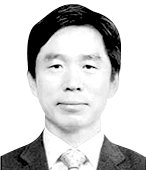Moon’s mixed nuclear flip

The author is a professor of mechanical engineering at Pusan National University.
In a recent Blue House meeting to check global energy supply networks, President Moon Jae-in stressed the need for the government to “make the best of nuclear reactors as a key energy source for the next 60 years.” That comment stirred controversy as he has fervently championed phasing out reactors since the start of his administration in 2017. About nuclear power plants under construction — such as the Shin Hanul No. 1 and No. 2 reactors and the Shin Kori No. 5 and No. 6 reactors — Moon urged officials to “check the current status of their construction to operate them as soon as possible.”
The media interpreted Moon’s remarks as a change in course in the government’s nuclear phase-out policy. Some people in the industry and some nuclear scientists welcomed the abrupt turnaround in government policy.
But a majority of nuclear experts are in despair. In the meeting, President Moon underscored the unavoidability of shifting the “energy mix” due to the risk of nuclear energy despite obvious advantages from nuclear power generation. He made clear his administration’s plan to “stop the construction of new reactors and disallow extending the life of aged reactors” toward the goal of “removing nuclear power in a phased way over the long term.” According to the plan, all nuclear reactors in Korea will disappear by 2084. Though Moon’s comment sounds like approval of nuclear reactors, it reaffirmed no shift in the government’s position on the nuclear phase-out.
Moon’s suggestion of an intention to use nuclear reactors as a key energy source over the next six decades does not make any sense. According to the plan, the share of reactors in the energy mix shrinks to 6.1 percent in 2050 from 29 percent in 2020. By 2080, only four reactors will remain, which account for less than 3 percent of the energy pie.
Moon’s instruction to accelerate the construction of the Shin Hanul No. 1 and No. 2 reactors and the Shin Kori No. 5 and No. 6 reactors to advance their activation also confounds us. Shin Hanul No. 1 and No. 2 should have been built by 2018 and 2019, respectively, but the first is undergoing a test run and the second has yet to test-run due to protracted construction. It will take two to three more years for the Shin Kori No. 5 and No. 6 reactors to be completed after their construction was delayed by an earthquake in Kyeongju, a nearby city, and by a government-sponsored public debate on the construction. Moon’s order does not make sense from the start as it is technically not possible to activate a nuclear reactor faster than scheduled.
Moon’s comment that a change in energy mix is unavoidable also is not convincing. An earlier plan to build nuclear reactors in Samcheok city and Yeongdeok County was scrapped even though the rural areas are not densely populated. Moon’s remarks are contradictory.
The president has showed a conciliatory reaction to growing public demands for nuclear energy after he destroyed the nuclear ecosystem — related industries and academia — over the last five years. Ordinary citizens unaware of the backgrounds and context of his remarks are prone to translate it as a dramatic shift in his position. But if you take a deeper look, nothing has changed.
Nuclear phase-out without feasible alternatives not only ruins our nuclear industry but also poses a serious threat to our energy security. And yet, the government steadfastly adheres to a misled faith in a self-destructive policy. Its campaign to help export Korean model reactors to other countries under such circumstances also dumbfounds us. What we need is not lip service from a head of state but a substantial change.
The EU has included nuclear reactors in the final draft of its “green taxonomy” — a list of 67 activities that help mitigate climate change. In 2017, French President Emanuel Macron promised to reduce the share of reactors in the country’s energy supply, but changed his position to reduce greenhouse gas emissions and create jobs.
Korea must restore its devastated nuclear ecosystem and export top-caliber reactors. The first step will be the resumption of the suspended construction of the Shin Hanul No. 3 and No. 4 reactors. The government also must prepare to extend the life of reactors whose operation is supposed to stop next year. The United States operates reactors up to 80 years. Korea shuts them down after 40 years? The time has come to scrap the nuclear phase-out policy.
Translation by the Korea JoongAng Daily staff.










with the Korea JoongAng Daily
To write comments, please log in to one of the accounts.
Standards Board Policy (0/250자)